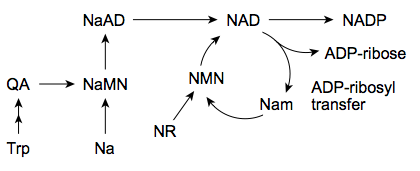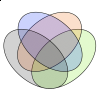What is the difference between these two supplements? I have chronic fatigue syndrome and am looking for a potent supplement to boost my energy and productivity. Does Niagen convert into NADH?

Difference between Niagen and NADH?
#1
Posted 05 September 2014 - 11:31 PM
#2
Posted 14 October 2014 - 11:15 PM
crazepharmacist,
Sorry one of dint see your post earlier.
Nicotinamide adenine dinucleotide This coenzyme is found in two forms in cells: (NAD+) is an oxidizing agent – it accepts electrons from other molecules and becomes reduced. This reaction forms (NADH,) which can then be used as a reducing agent to donate electrons.
As far as I know NAD+ can not be readily taken as a nutrient. It is broken down into its parts in the digestive system.
Niagen is a brand name for Nicotinamide Riboside or (NR). It is produced under a patent by ChromaDex. Here is a link to some of the suppliers http://www.longecity...nd-discussion/
Nicotinamide Riboside can be used as a building block for Nicotinamide adenine dinucleotide and can be taken orally and can likely be absorbed sublingual like Niacin or Nicotinamide. The first human clinical trials just wrapped up and we are looking forward to some Pharmacokinetics data to tie the animal studies to human metrics.
In short Niagen or (NR) is a precursor to NAD+ and enters into the NAD coenzyme salvage path.

NAD salvage pathway - right side.
I'm sure many factors can cause chronic fatigue syndrome, will this help, I cant say with any certainty but don't think it will hurt.
#3
Posted 16 October 2014 - 04:45 PM
Yes, apparently NAD seems to be available orally, which is demonstrated within this reference:
http://teamtlr.com/a...ide-nad-99.html ![]()
#4
Posted 20 October 2014 - 04:12 PM
Released 2007/06/15
https://www.jstage.j...2/52_2_142/_pdf
With all do respect your page is quite clear; "USAGE: For Research Use Only! Not For Use in Humans." I'm going to put something in my body you yourself say I shouldn't? It can be taken orally then what? "In fact, incubation of NADH at acidic pH to mimic the stomach resulted in rapid conversion of NADH to an unknown compound." It has been shown that orally taken NAD+ also supplies Nam (Nicotinamide), since NAD+ is metabolized to Nam (Nicotinamide) in the small intestinal tract (1). In contrast, the metabolic fate of oral NADH is unclear. It appears that instability of NADH in an acidic condition (gastric juice) (4) has made it difficult to pursue its fate.
Seems clear to me Nicotinamide which is sold for human consumption through a number of venders would be a more sensible path if Nam (Nicotinamide) is what I wanted, because NAD+ is metabolized to Nam (Nicotinamide) in the small intestinal tract anyway. Injection is another path but I and many others wont go there. Plus the NAD+ on your page isn't formulated for injection or for human consumption anyway, correct?
#5
Posted 20 October 2014 - 04:40 PM
Read the study as cited (1) as to the metabolic fate of NR as well
Digestion and absorption of NAD by the small intestine of the rat.
A number of preparations of varying complexity have been used in an effort to elucidate the reactions by which NAD is hydrolyzed to nicotinamide during intestinal digestion. NAD labeled with 14C in the adenine or pyridine moiety was the substrate used with perfused rat intestine, live rats, perfused live rats, with collection of portal flow, intestinal contents, mucosal tissue, or pancreatic juice. The conclusions reached are that a pyrophosphatase present in the intestinal juice and to a much lesser extent in the pancreatic juice releases 5'-AMP and nicotinamide ribonucleotide. The 5'-AMP was rapidly converted to adenosine then to inosine by bacteria-free intestinal contents. Perfused or intact intestine rapidly hydrolyzed NMN to nicotinamide riboside, which accumulated, but was not absorbed. It was slowly cleaved by an enzyme associated with the mucosal cells to nicotinamide, which was the major if not the only labeled compound absorbed.
Hence there is some interest in intranasal animal research within our Team as to the best method for CNS as well as systemic increase of NAD+/NADH levels.
Maybe post this in your group buy thread so people are aware as well as to background science on intestinal absorption of all related NADH 'fostering' substrates.
Notably, some studies are poor or actually biased, but the one above seems very clear and distinct within its assertions.
As well, Dr. Sinclair seems to advocate from his evaluation that oral NAD may be a superior method of elevation.
Hence, why we have availed this in pure powder for further research. Make sense...?
Anyway, our goal is to advance science and understanding, but opposition by those who seem to be of like mind may make such more difficult that need be. ![]()
Edited by VERITAS INCORRUPTUS, 20 October 2014 - 04:47 PM.
#6
Posted 20 October 2014 - 05:58 PM
Read the study as cited (1) as to the metabolic fate of NR as well
J Nutr. 1983 Feb;113(2):412-20.Digestion and absorption of NAD by the small intestine of the rat.
AbstractA number of preparations of varying complexity have been used in an effort to elucidate the reactions by which NAD is hydrolyzed to nicotinamide during intestinal digestion. NAD labeled with 14C in the adenine or pyridine moiety was the substrate used with perfused rat intestine, live rats, perfused live rats, with collection of portal flow, intestinal contents, mucosal tissue, or pancreatic juice. The conclusions reached are that a pyrophosphatase present in the intestinal juice and to a much lesser extent in the pancreatic juice releases 5'-AMP and nicotinamide ribonucleotide. The 5'-AMP was rapidly converted to adenosine then to inosine by bacteria-free intestinal contents. Perfused or intact intestine rapidly hydrolyzed NMN to nicotinamide riboside, which accumulated, but was not absorbed. It was slowly cleaved by an enzyme associated with the mucosal cells to nicotinamide, which was the major if not the only labeled compound absorbed.
If the NR requires action on it by an enzyme in order to be absorbed, it makes me wonder if co-supplementation with that enzyme, or perhaps a pro-biotic, might be helpful.
Howard
#7
Posted 20 October 2014 - 06:10 PM
Animal research is fine since "USAGE: For Research Use Only! Not For Use in Humans."
And yes we are looking at a number of precursors. The group buy thread is focused only on NR for those people with that interest. However we have a number of other threads where we are openly discussing other NAD precursors.
#8
Posted 21 October 2014 - 03:02 AM
As well, Dr. Sinclair seems to advocate from his evaluation that oral NAD may be a superior method of elevation.
Do you have a reference?
#9
Posted 21 October 2014 - 03:22 AM
My apologies, as I just recalled reading it somewhere, but do not recall the source.
This may be of further interest though:
Prevention of Traumatic Brain Injury-Induced Neuron Death by Intranasal Delivery of Nicotinamide Adenine Dinucleotide
"Traumatic brain injury (TBI) is one of the most devastating injuries experienced by military personnel, as well as the general population, and can result in acute and chronic complications such as cognitive impairments. Since there are currently no effective tools for the treatment of TBI, it is of great importance to determine the mechanisms of neuronal death that characterize this insult. Several studies have indicated that TBI-induced neuronal death arises in part due to excessive activation of poly(ADP-ribose) polymerase-1 (PARP-1), which results in nicotinamide adenine dinucleotide (NAD+) depletion and subsequent energy failure. In this study, we investigated whether intranasal administration of NAD+ could reduce neuronal death after TBI. Rats were subjected to a weight-drop TBI model that induces cortical and hippocampal neuronal death. The intranasal administration of NAD+ (20 mg/kg) immediately after TBI protected neurons in CA1, CA3, and dentate gyrus of the hippocampus, but not in the cortex. In addition, delayed microglial activation normally seen after TBI was reduced by NAD+ treatment at 7 days after insult. Neuronal superoxide production and PARP-1 accumulation after TBI were not inhibited by NAD+ treatment, indicating that reactive oxygen species (ROS) production and PARP-1 activation are events that occur upstream of NAD+ depletion. This study suggests that intranasal delivery of NAD+ represents a novel, inexpensive, and non-toxic intervention for preventing TBI-induced neuronal death."
Edited by VERITAS INCORRUPTUS, 21 October 2014 - 03:31 AM.
#10
Posted 25 February 2017 - 11:39 PM
If you haven't tried sublingual NADH at 10 mg or 20 mg, it should be worth a try, if only to rule them out.
I would first take niacin at least 100 mg; a dose that typically should not cause a flush. You can then add niacinamide at 250mg x2 and then 500mg x2. Later you can add NR chloride (Niagen), initially at 100mg x2, graduating to 250mg x2. Keep taking niacin and niacinamide no matter what.
Basically, it's difficult to be sure about NR and sublingual NADH without trying for at least a week or two in gradually increased doses.
Finally, you can add a methylator or two to see if NR works better that way. Alternatively, add a stimulant and see if NR synergizes with it, for it just might.
Edited by Climactic, 25 February 2017 - 11:42 PM.
Also tagged with one or more of these keywords: niagen, nadh, difference
2 user(s) are reading this topic
0 members, 2 guests, 0 anonymous users






























 This topic is locked
This topic is locked












